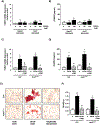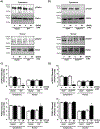Cytochrome P450 2E1-dependent hepatic ethanol metabolism induces fatty acid-binding protein 4 and steatosis
- PMID: 35403271
- PMCID: PMC9246908
- DOI: 10.1111/acer.14828
Cytochrome P450 2E1-dependent hepatic ethanol metabolism induces fatty acid-binding protein 4 and steatosis
Abstract
Background: Hepatic steatosis is an early pathology of alcohol-associated liver disease (ALD). Fatty acid-binding protein-4 (FABP4, a FABP not normally produced in the liver) is secreted by hepatocytes in ALD and stimulates hepatoma proliferation and migration. This study sought to investigate the mechanism[s] by which hepatic ethanol metabolism regulates FABP4 and steatosis.
Methods: Human hepatoma cells (HepG2/HuH7) and cells stably transfected to express cytochrome P450 2E1 (CYP2E1), were exposed to ethanol in the absence or presence of chlormethiazole (a CYP2E1-inhibitor; CMZ) and/or EX-527 (a sirtuin-1 [SIRT1] inhibitor). The culture medium was analyzed for ethanol metabolism and FABP4 protein abundance. Cells were analyzed for FABP4 mRNA expression, SIRT1 protein abundance, and neutral lipid accumulation. In parallel, cells were analyzed for forkhead box O1 [FOXO1], β-catenin, peroxisome proliferator-activated receptor-α [PPARα], and lipin-1α protein abundance in the absence or presence of ethanol and pharmacological inhibitors of the respective target proteins.
Results: CYP2E1-dependent ethanol metabolism inhibited the amount of SIRT1 protein detected, concomitant with increased FABP4 mRNA expression, FABP4 protein secretion, and neutral lipid accumulation, effects abolished by CMZ. Analysis of pathways associated with lipid oxidation revealed increased FOXO1 nuclear localization and decreased β-catenin, PPARα, and lipin-1α protein levels in CYP2E1-expressing cells in the presence of ethanol. Pharmacological inhibition of SIRT1 mimicked the effects of ethanol, while inhibition of FOXO1 abrogated the effect of ethanol on FABP4 mRNA expression, FABP4 protein secretion, and neutral lipid accumulation in CYP2E1-expressing cells. Pharmacological inhibition of β-catenin, PPARα, or lipin-1α failed to alter the effects of ethanol on FABP4 or neutral lipid accumulation.
Conclusion: CYP2E1-dependent ethanol metabolism inhibits SIRT1-FOXO1 signaling, which leads to increased FABP4 mRNA expression, FABP4 protein secretion, and neutral lipid accumulation. These data suggest that FABP4 released from steatotic hepatocytes could play a role in promoting tumor cell expansion in the setting of ALD and represents a potential target for therapeutic intervention.
Keywords: cytochrome P450 2E1; ethanol; fatty acid-binding protein-4; sirtuin-1; steatosis.
© 2022 by the Research Society on Alcoholism.
Conflict of interest statement
Figures






References
-
- Cahill A, Cunningham CC (2000) Effects of chronic ethanol feeding on the protein composition of mitochondrial ribosomes. Electrophoresis 21:3420–3426. - PubMed
Publication types
MeSH terms
Substances
Grants and funding
LinkOut - more resources
Full Text Sources
Medical
Research Materials
Miscellaneous

